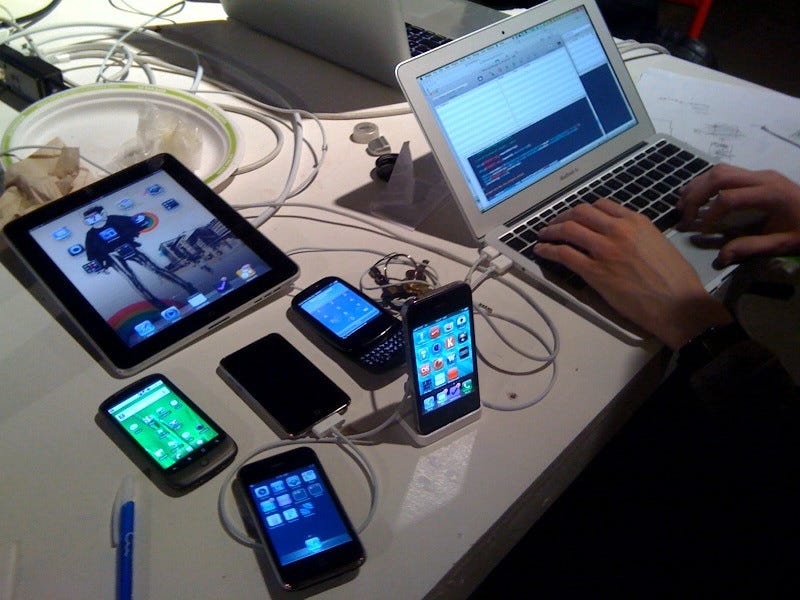Latest news about Bitcoin and all cryptocurrencies. Your daily crypto news habit.
 Source: Flickr
Source: Flickr
Over the course of the last two decades, organizations the world over began to realize that without a sufficient presence on the web, chances of business success diminished significantly. As time has gone on, the extent of that web presence has broadened. Social media profiles, optimized pages, and mobile-responsive websites have all become commonplace and, some would say, necessary to conduct business in the modern age. Add now to that list the mobile business application, or the “app.”
We all know what mobile apps are — software applications designed for use specifically on tablets, smartphones, and other mobile devices. You generally download them through an app store specific to your mobile operating system, such as Apple’s App Store or Google Play. These apps might be games (think Candy Crush or Flappy birds), utility or office programs (Gmail and Slack are good examples), or even shopping or service portals (the Amazon and Uber apps fit well in this category).
The popularity and growth of “all things mobile” are important to try to understand for anybody in the app development sector. In 2015 mobile devices downloaded a combined 10 billion gigabytes of data. By 2020, mobile apps are predicted to be worth approximately 189 billion U.S. dollars in revenues via app stores and in-app advertisement. Also, according to Statista, “as of March 2017, there were 2.8 million available apps at Google Play Store and 2.2 million apps available in the Apple’s App Store, the two leading app stores in the world.”
Interestingly, while app usage continues to grow and revenue also mounts, Sarah Perez with TechCrunch reports that the majority of U.S. consumers actually download zero apps per month.
Mobile app developers are probably quite familiar with the decline in app downloads, and have been for some time. Recode ran an article in mid-2016, that begins: “The mobile app boom kicked off in July 2008, when Apple introduced the App Store. Now it is over.”
It seems like a paradox: people are sick of downloading apps — but apps are more popular than ever. So what does this mean for the future of app development, and the future of apps themselves?
The IoT and the Cloud Connection
 Source: Pexels
Source: Pexels
The main takeaway here is that people want to use apps, but they’re sick of downloading them. People want things fast, simple, and easy. For example, in early 2018, Google implemented changes that take into account the loading speed of websites on mobile devices when determining ranking in their results pages. It’s far from the only ranking factor, but it heralds a serious shift toward a mobile-friendly world. Google has signaled their recognition that the mobile experience is extremely important to a vast majority of internet users. If you’re not already investing in responsive web design, you’re behind.
Business leaders, employees, and consumers alike are calling for mobile-first technology solutions, providing them instant and easy access to static data across multiple devices. This growing web of devices and sensors is known as the internet of things, or the IoT.
“The driving force behind the growing mobility market is the impact of the IoT and its broad reach,” write the experts at Maryville University online. “IoT connections reach into transportation, energy, and agriculture sectors and are forecasted to boost the evolution of mobility strategy.”
In the future, apps will need to “speak” to each other, in the same way that devices in the IoT communicate — in fact, the cloud and its ability connect so many disparate things via APIs and containers will be essential in the light, low-code future of app development.
The Future is Bright. The Future is Light.
 Source: Pexels
Source: Pexels
Earlier this year, Kevin Rands, writing for CIO, says that if you haven’t yet heard of the low-code approach to app development, you’d better brace yourself, because you’re about to.
“The streamlined approach involves rapid design and development with minimal amounts of coding, often relying on third-party application programming interfaces (APIs),” he says. “There’s not really any individual definition of low code development because it’s more of a mindset than something that’s directly measurable. But the very fact that it’s a mindset has led to a community springing up around the mentality, and low code innovators are increasingly disrupting all sorts of different industries.”
Rands argues that low-code platforms present lower costs, fewer bugs, greater accessibility, and and overall brand new type of development. He points to Uber as one of the most promising examples of a low-code platform, as it “Box for storage, Google for maps, Braintree for payments, Twilio for messaging and SendGrid for email,” among other things.
These low-code platforms would, ideally, consist of two parts; a WYSIWYG interface builder of sorts, and a language that is syntactically similar to human-like speech rules and patterns. It is this simplicity that will actually change app development the most.
App Developers and the Cloud Shift to Data Science
 Source: Pexels
Source: Pexels
The low-code platform will simultaneously lead to the rise and demise of the application developer as we know it — or, at least, Carlos Melendez, writing for InfoWorld, seems to think so.
“The demise of the application developer will be most noticeable in traditional, non-tech markets, as sophisticated business users, with easy-to-use, customizable tools at the ready, know what they want and easily code their own scripts,” writes Melendez. “Yet within technology companies building more complex cognitive solutions, the need for people to maintain and manage these apps will continue.”
As such, Melendez believes that traditional app developers and software engineers in non-tech markets may want to consider honing their skills in data science, cloud operations, and security, technologies. He points to these areas as those that will be in high demand; the result of an evolving, complex, data-driven market on the rise
While nobody can predict the future with absolute certainty, the way that app development is progressing is similar to the way that traditional software has in the past. After the “ground level” was built, software libraries began to integrate and interact within one another — we’re at that same point, the difference is that these “libraries” exist in the cloud.
Though the future of app development is not yet certain, we can look to the past for reference and to predict what’s yet to come. It’s a good bet that in the future the field will be heavily saturated with data points and API connections — and this says nothing of app development on the blockchain (dApps).
What we can say for certain is that the future of app development will look vastly different than it’s contemporary iteration. Developers would do well to begin preparing for that future.
The Future of App Development was originally published in Hacker Noon on Medium, where people are continuing the conversation by highlighting and responding to this story.
Disclaimer
The views and opinions expressed in this article are solely those of the authors and do not reflect the views of Bitcoin Insider. Every investment and trading move involves risk - this is especially true for cryptocurrencies given their volatility. We strongly advise our readers to conduct their own research when making a decision.
